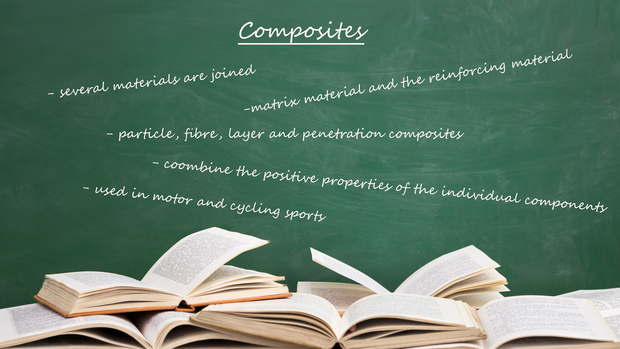A composite material is a material in which several materials are joined.
At least two materials must be used, which are referred to as matrix material or
binding material and reinforcing material. In principle, any material can be used as a matrix material.
However, there must be sufficient adhesion between the matrix material and
the reinforcing material so that the resulting composite material can reliably fulfil its subsequent task.
Composite materials are divided into four types: particle, fibre, layer and penetration composites.
In particle composites, the reinforcing material is in the form of particles in the matrix.
In fibre composites, on the other hand, the reinforcing material is in the form of fibres,
which can have different lengths and orientations. In layered composites, the materials are
in layers on top of each other, whereby the thickness of the layers is variable. In the last form of composite,
the interpenetration composite, a low-melting metal, such as copper, is sucked in by a higher-melting metal,
such as tungsten. This creates a composite similar to a joint.
Properties of composites
The composite material has different properties than the materials it is made of, i.e. its individual components.
As far as possible, the positive properties of the individual components should be combined in the composite material and
negative properties compensated for. Composite materials have high rigidity, load-bearing capacity and flexibility.
They are corrosion-resistant, but difficult to recycle. Especially composites with duromer matrix cannot be
recycled because they are not chemically or soluble. Duromers are plastics that cannot be deformed after
curing due to insoluble polymers. Often, the raw materials also have certain properties.
For example, the reinforcing material increases stiffness, tensile strength and resistance to acids and
high temperatures. The matrix material, on the other hand, ensures the cohesion of the materials,
provides a certain thermal conductivity and offers corrosion resistance.
Composites are connections that are created by material or form closure. However, a combination of both is also possible. The production of a composite material from a metal matrix material is usually more complicated than from a plastic matrix material. To obtain a particle or fibre composite material, particles or fibres are embedded in the chosen matrix. A fibre composite can also be produced in layers, but this does not make it a layered composite, as layers of the same type are layered here. In a layered composite, layers of different types are placed on top of each other, creating the typical layered composite. A penetration composite is made by impregnating an open-pored material with a molten material. Composites are often used in motor and cycling sports, or as wings for aeroplanes or in space travel.
Do you want to have a milled or turned part made from a composite material?
Or are you interested in having your desired component milled or drilled with the help of contract manufacturing?
Submit your enquiry quickly and easily and we will get back to you with a quote in line with the market.
We look forward to hearing from you.


